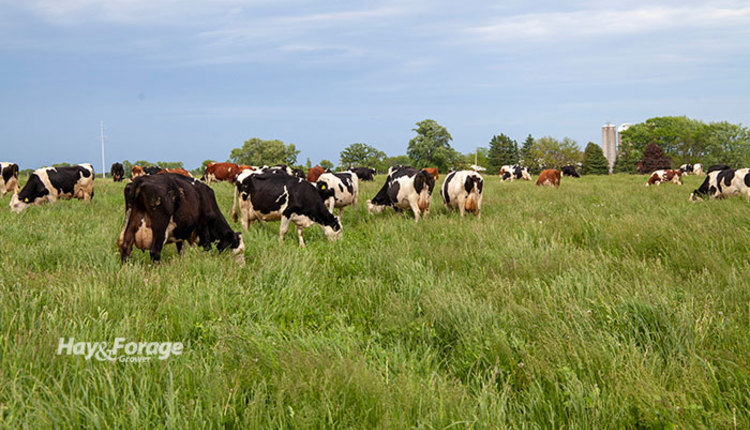
Rotational grazing requires flexibility, especially when it comes to grazing dairy cattle. While this practice is useful to avoid the costs of harvesting and storing feed, a system must be set up to properly address a dairy cow’s high nutrient needs.
Donna Amaral-Philips, extension professor at the University of Kentucky, notes the basic components of a grazing system include plant species, rotation pattern, and paddock design. She explains how to manage each of these factors to optimize forage quality and availability for better dairy cow performance in a recent KY Dairy Notes article.
Graze young, vegetative growth. Energy and protein levels are greater in forage before it reaches maturity. After this point, it starts to accumulate more lignin in its cell walls and becomes less digestible in the rumen. This can limit intake and lower milk production.
In addition to growth stage, energy and protein levels vary among different parts of plants, too. Amaral-Philips says the first bite of forage from the tops of plants is highest in nutrient concentration. Then, as cattle continue to graze, nutrient concentration declines.
“The lower part of legume and grass plants contains more fibrous stem than the upper parts,” Amaral-Philips says. “Requiring animals to consume most of the plant in a single pass results in more even consumption of nutrients.”
Give forage time to rest and recover. Rest paddocks for 28 to 35 days between grazing events. Don’t let animals graze grass forages below 3 to 4 inches as these species regrow from tillers near the soil surface. Legumes, on the other hand, use carbohydrates stored in their roots to facilitate regrowth, so they can be grazed shorter. Nonetheless, avoid overgrazing any kind of forage to promote stand persistence.
“Closer grazing increases the time of regrowth; decreases survivability of the plants, especially during drought conditions; and decreases the nutrition provided to the dairy cow,” Amaral-Philips states.
Maintain dry matter intake. “Dry matter intake on grazed forages is determined by bite rate, time spent grazing, and bite size,” Amaral-Philips says. “Cattle are usually capable of 50 to 70 bites of forage per minute, spend approximately eight hours a day grazing, and average a bite size of 0.2 ounces per bite. Bite size is the most variable of these three factors.”
Bite size correlates to forage height and stand density; however, these factors may be compromised when cool-season grasses hit the summer slump. Utilizing other forages can help make up for this lack of production.
“Cool-season grasses such as orchardgrass and fescue do not grow when temperatures exceed 70°F,” the extension professor notes. “Alfalfa, sudangrass, pearl millet, or other warm-season perennials will grow during summertime temperatures and in full-sun radiation.”
Brown midrib hybrids of sorghum species improve digestibility because they have less lignin. With that said, wait to turn animals out on sorghums, sudangrass, or johnsongrass until plants are at least 18 inches tall to reduce the risk of prussic acid poisoning.
Provide plenty of water and shade. Ensure each paddock is equipped with a water source. According to Amaral-Philips, dairy cattle that produce 50 pounds of milk drink about 25 gallons of water per day when it is 60°F. At 90°F, animals will need at least 30 gallons of water per day. Shade is also essential for cow comfort and to prevent environmental mastitis. Graze cattle in areas with trees or give animals access to a barn.

Amber Friedrichsen is the 2022 Hay & Forage Grower editorial intern. She currently attends Iowa State University where she is majoring in agriculture and life sciences education-communications and agronomy. Friedrichsen grew up on her family’s diversified crop and livestock farm near Clinton, Iowa.

